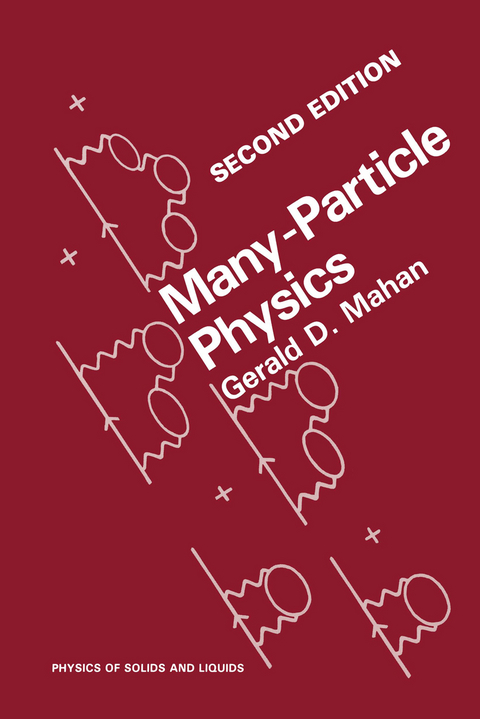
Many-Particle Physics
Kluwer Academic/Plenum Publishers (Verlag)
978-0-306-43423-5 (ISBN)
1. Introductory Material.- 1.1. Harmonic Oscillators and Phonons.- 1.2. Second Quantization for Particles.- 1.3. Electron — Phonon Interactions.- 1.4. Spin Hamiltonians.- 1.5. Photons.- 1.6. Pair Distribution Function.- Problems.- 2. Green’s Functions at Zero Temperature.- 2.1. Interaction Representation.- 2.2. S Matrix.- 2.3. Green’s Functions.- 2.4. Wick’s Theorem.- 2.5. Feynman Diagrams.- 2.6. Vacuum Polarization Graphs.- 2.7. Dyson’s Equation.- 2.8. Rules for Constructing Diagrams.- 2.9. Time-Loop S Matrix.- 2.10. Photon Green’s Functions.- Problems.- 3. Green’s Functions at Finite Temperatures.- 3.1. Introduction.- 3.2. Matsubara Green’s Functions.- 3.3. Retarded and Advanced Green’s Functions.- 3.4. Dyson’s Equation.- 3.5. Frequency Summations.- 3.6. Linked Cluster Expansions.- 3.7. Real Time Green’s Functions.- Wigner Distribution Function.- 3.8. Kubo Formula for Electrical Conductivity.- 3.9. Other Kubo Formulas.- A. Pauli Paramagnetic Susceptibility.- B. Thermal Currents and Onsager Relations.- C. Correlation Functions.- Problems.- 4. Exactly Solvable Models.- 4.1. Potential Scattering.- 4.2. Localized State in the Continuum.- 4.3. Independent Boson Models.- 4.4. Tomonaga Model.- 4.5. Polaritons.- Problems.- 5. Electron Gas.- 5.1. Exchange and Correlation.- 5.2. Wigner Lattice and Metallic Hydrogen.- Metallic Hydrogen.- 5.3. Cohesive Energy of Metals.- 5.4. Linear Screening.- 5.5. Model Dielectric Functions.- 5.6. Properties of the Electron Gas.- 5.7. Sum Rules.- 5.8. One-Electron Properties.- Problems.- 6. Electron-Phonon Interaction.- 6.1 Fröhlich Hamiltonian.- 6.2 Small Polaron Theory.- 6.3 Heavily Doped Semiconductors.- 6.4 Metals.- Problems.- 7. dc Conductivities.- 7.1. Electron Scattering by Impurities.- 7.2. Mobility of FröhlichPolarons.- 7.3. Electron-Phonon Interactions in Metals.- 7.4. Quantum Boltzmann Equation.- Problems.- 8. Optical Properties of Solids.- 8.1. Nearly Free-Electron System.- 8.2. Wannier Excitons.- 8.3. X-Ray Spectra in Metals.- Problems.- 9. Superconductivity.- 9.1. Cooper Instability.- 9.2. BCS Theory.- 9.3. Electron Tunneling.- 9.4. Infrared Absorption.- 9.5. Acoustic Attenuation.- 9.6. Excitons in Superconductors.- 9.7. Strong Coupling Theory.- Problems.- 10. Liquid Helium.- 10.1. Pairing Theory.- 10.2. 4He: Ground State Properties.- 10.3. 4He: Excitation Spectrum.- 10.4. 3He: Normal Liquid.- 10.5. Superfluid 3He.- Problems.- 11. Spin Fluctuations.- 11.1. Kondo Model.- 11.2. Anderson Model.- Problems.- References.- Author Index.
| Erscheint lt. Verlag | 31.3.1990 |
|---|---|
| Reihe/Serie | Physics of Solids and Liquids |
| Zusatzinfo | XIV, 1032 p. |
| Verlagsort | New York |
| Sprache | englisch |
| Maße | 152 x 229 mm |
| Themenwelt | Naturwissenschaften ► Physik / Astronomie ► Atom- / Kern- / Molekularphysik |
| ISBN-10 | 0-306-43423-7 / 0306434237 |
| ISBN-13 | 978-0-306-43423-5 / 9780306434235 |
| Zustand | Neuware |
| Haben Sie eine Frage zum Produkt? |
aus dem Bereich


